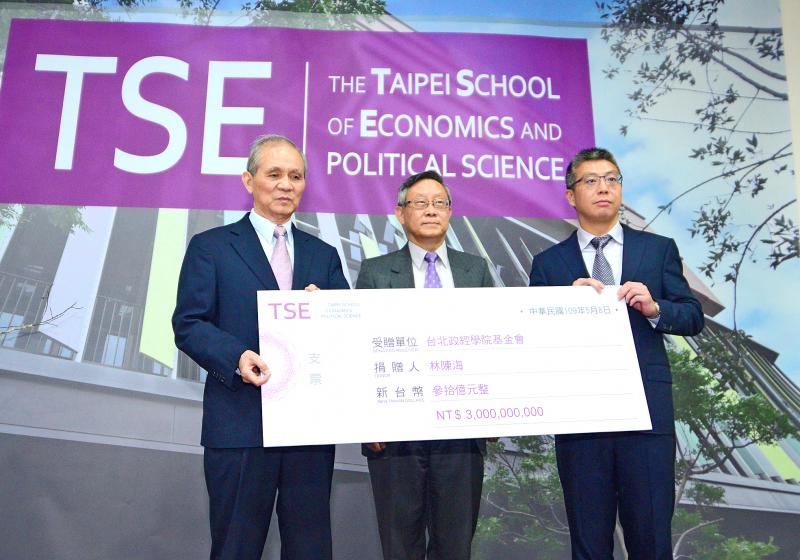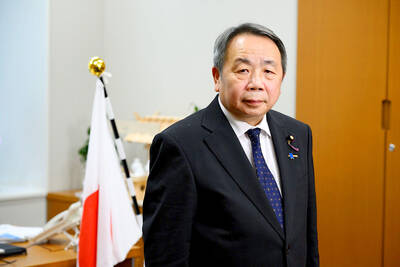National Tsing Hua University and a private foundation yesterday signed a contract in Taipei to found the Taipei School of Economics and Political Science (TSE).
Signed by TSE foundation chairman Huang Huang-hsiung (黃煌雄) and university president Hocheng Hong (賀陳弘), the school represents the first collaboration in the nation between a private foundation and a public institution to set up an educational institution.
The TSE is to be established inside the Hsinchu-based university, becoming the 11th college on campus, Huang said, adding that it plans to admit 10 graduate students in September next year, before gradually raising the number to 30 doctoral and 150 graduate students each year.

Photo: Wang Yi-sung, Taipei Times
International students are expected to make up two-thirds of the studentry, with all courses taught in English, he said, adding that graduation diplomas will be conferred by the university.
The university has been the cradle of numerous talent in science and technology, making it an ideal partner to run the TSE, which seeks to cultivate professionals in politics, economics, new technologies and sustainable development, he said.
The inspiration for founding the school was the London School of Economics and Political Science (LSE), which was founded in 1895 by members of the Fabian Society for the betterment of society, he said.
Minister of Education Pan Wen-chung (潘文忠) attended the signing ceremony.
Lin Chen-hai (林陳海), the main donor who set up a NT$3 billion (US$100 million) fund for the TSE, said the interest generated by the fund would be used as operating expenditure for the school, which is estimated to be about NT$100 million each year, said his son, Lin Chia-hung (林家宏).
The establishment of the TSE is a groundbreaking experiment on higher education innovation and globalization in Taiwan, while the scale of funds injected into the school for the development of social science is unprecedented, Hocheng said.
TSE combines the prestige of the public sector with the flexibility and resources of the private sector, making it the first of its kind in Taiwan, and extremely rare in Asia, Hocheng said, adding that he is certain it would greatly raise the nation’s global profile.
Additional reporting by CNA

A strong continental cold air mass is to bring pollutants to Taiwan from tomorrow, the Ministry of Environment said today, as it issued an “orange” air quality alert for most of the country. All of Taiwan except for Hualien and Taitung counties is to be under an “orange” air quality alert tomorrow, indicating air quality that is unhealthy for sensitive groups. In China, areas from Shandong to Shanghai have been enveloped in haze since Saturday, the ministry said in a news release. Yesterday, hourly concentrations of PM2.5 in these areas ranged from 65 to 160 micrograms per cubic meter (mg/m³), and pollutants were

Taiwan’s armed forces have established response protocols for a wide range of sudden contingencies, including the “Wan Chun Plan” to protect the head of state, the Ministry of Defense (MND) said today. After US President Donald Trump on Saturday launched a series of airstrikes in Venezuela and kidnapped Venezuelan President Nicolas Maduro, concerns have been raised as to whether China would launch a similar “decapitation strike” on Taiwan. The armed forces regularly coordinate with relevant agencies and practice drills to ensure preparedness for a wide range of scenarios, Vice Minister of National Defense Hsu Szu-chien (徐斯儉) told reporters before a

EVA Airways on Saturday said that it had suspended a pilot and opened an investigation after he allegedly lost his temper and punched the first officer several times as their plane was taxiing before takeoff at Los Angeles International Airport. According to a report published on Thursday by The Reporter, the incident occurred after the flight’s Malaysian first officer tried to warn the Taiwanese pilot, surnamed Wen (文), that he was taxiing faster than the speed limit of 30 knots (55.6kph). After alerting the pilot several times without response, the first officer manually applied the brakes in accordance with standard operating

Japanese Councilor Hei Seki (石平) on Wednesday said that he plans to visit Taiwan, saying that would “prove that Taiwan is an independent country and does not belong to China.” Seki, a member of the Japan Innovation Party, was born in Chengdu in China’s Sichuan Province and became a naturalized Japanese in 2007. He was elected to the House of Concilors last year. His views on the Chinese Communist Party (CCP) — espoused in a series of books on politics and history — prompted Beijing to sanction him, including barring Seki from traveling to China. Seki wrote on X that he intends